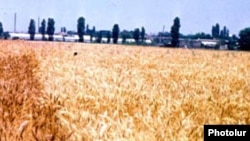The mountainous country of three million consumes an estimated 650,000 metric tons of wheat each year. According to government statistics, only roughly one third of the crop is grown domestically.
Officials said Armenian farmers should be able to meet more than half of the demand already in 2013. The government allocated 558 million drams ($1.5 million) for the purchase of 1,000 tons of “elite” seeds this year.
The bulk of them are to be imported from Russia. According to Agriculture Minister Gerasim Alaverdian, farmers will be able to pay for the seeds in kind, after collecting their harvest.
In a written statement, the government said it will also support Armenian agricultural firms growing such seeds. “Demand in wheat seeds will thereby be fully satisfied [by local producers] in three to four years,” said the statement issued after a weekly meeting of Prime Minister Tigran Sarkisian’s cabinet.
Alaverdian predicted that domestic wheat production will rise to 350,000 tons in 2013. “That will allow us to expand the total area of land used for grain crops to about 120,000 hectares and increase the total wheat yield to 400,000-420,000 tons, which will raise the rate of our self-sufficiency from 37 percent to 55 percent,” he told journalists.
The government has already pledged to make Armenian more self-sufficient in this and other basic foodstuffs in the past. In March 2008, for example, it set about drawing up a plan of actions that would encourage farmers to grow more wheat and raise their share in the domestic market to as much as 75 percent by 2015.
However, Armenian wheat fields have slowly but steadily shrunk in recent years, with many villagers switching to other crops or cattle-breeding due to a lack of irrigation and resulting poor yields. According to the Armenian Ministry of Agriculture, this was one of the reasons why the country’s wheat output shrunk by over 10 percent last year.
The outlook for this year is not necessarily more positive. An unusually rainy spring accompanied by hailstorms has inflicted serious damage on Armenian agriculture.
In the northwestern Shirak region, hail destroyed a large part of the wheat crop planted last fall. As a result, some local villagers, most of them subsistence farmers, decided not to grow wheat anymore. “Fuel is expensive, planting and harvesting is expensive, and you get no revenues,” explained local one woman.
“I planted one hectare this spring,” another farmer told RFE/RL’s Armenian service. “But can I recoup my expenditures? No.”
In Alaverdian’s words, the government hopes to minimize the devastating effects of bad weather by purchasing and deploying 250 hail cannon systems in the country’s main agricultural regions by the end of 2012. “Twenty-eight systems are now ready, and another 48 systems will be deployed by the end of the year,” he said.
Some wheat farmers in another northern region, Lori, claimed to have had trouble finding wholesale buyers for their produce. “Last year, I collected six tons of wheat,” one man in the local village of Gargar told RFE/RL’s Armenian service. “It was a good one. But our state did not buy it and imported wheat from Russia instead.”
But Alaverdian dismissed such claims. “There should not be any problems with sales,” he said. “At least, we have no information that our villagers have difficulty selling wheat.”




